Analys
More for longer and highly vulnerable ($75-85/bl)


The message from Saudi Arabia is now that it will take longer than first expected before production is fully back to normal. We are also getting military assessments saying that attacks of the nature seen on Saturday in Saudi Arabia are fundamentally difficult to protect against and that you basically need to take out the threat before it lifts off the ground. So more for longer and highly vulnerable for future, comparable attacks is the current assessment.
That is all together more bullish than the market action during most of Monday trading session when Brent crude after the first initial spike to close to $72/bl quite quickly fell back again to ~$65/bl.
We have lived so long now with abundant and booming US shale oil production growth that it is hard to shake the market out of its overwhelming sense of affluence. And in some aspects the market has some rights in being relaxed as OECD commercial inventories in July stood some 300 m bl above where they were in mid-summer 2014 while non-OPEC supply will grow strongly in 2020.
The current cooling global economic growth is also having a strongly dampening impact on the oil market sentiment. We don’t need to go further back than late April when we had a Brent crude oil price of close to $75/bl. Following Saturday’s strike at the center of the global oil market the oil price did not even manage to get up to the level where Brent traded for more normal reasons in April. That tells you that there is quite a broad based sentiment holding a bearish hand over the market.
It has been reported that US shale oil players are utilizing the bounce in the oil prices as an opportunity to add forward hedges at higher prices. I.e. their main take at the moment is that oil prices will likely fall back again rather than spiral upwards. So take the added gain in prices and run.
Speculators with short positions in the market may however think differently in the face of more outage for longer in Saudi Arabia and fundamentally vulnerable installations versus future potential attacks. It would be sensible to cut the losses and close such short positions for now in our view given the latest information. Consumers who have held back on forward buying in the hope for lower forward prices for 2020 and 2021 may also cave in and buy before a potential new attack on Saudi Arabia’s oil installations materializes.
Thus while market participants are still quite relaxed about the whole situation they may now gradually start to change their mind with shorts likely covering positions and consumers buying before any new attacks potentially can occur.
So what about counter attacks? Saudi Arabia is now fully blaming Iran (or at least saying it was Iranian military material) and has stated that the attack was a mix of Iranian drones and rockets. Given the severity of the attack on Saturday it is difficult to see how Saudi Arabia cannot retaliate. But if Saudi Arabia is fundamentally vulnerable and unable to protect itself from comparable future attacks how can they retaliate? It would seem to be more or less like asking for yet more damages to Saudi Arabia’s oil infrastructure down the road.
Donald Trump on the other hand has pulled away from “Locked and loaded” and stated that what he meant was that the US is loaded with oil and with no need for Middle East oil. What a great twist!!
When Donald Trump kicked out the US national security adviser John Bolton one week ago it looked like Donald Trump wanted to move towards negotiations with Iran’s president Hassan Rouhani.
If the US now joins in with Saudi Arabia with a retaliatory attack on Iran it would weaken president Rouhani while it would strengthen the position of Iran’s Revolutionary Guard which is probably the once who stood behind Saturday’s attack on Saudi Arabia in the first place. I.e. it would strongly reduce the possibility for the US to move down a negotiating path with president Rouhani which is probably what is needed in order to get out of this mess.
Ram Yavne, a retired brigadier general in the Israel Defense Forces has stated according to Bloomberg: “Iranian’s have tried several times to raise the price of oil to show the world that the price for blocking Iran’s ability to produce oil is very high”.
Even though the US now has become more or less self sufficient with oil (at least if you include imports from Canada) and that it does not need to entangle it selves in armed conflicts in the Middle East in order to safeguard supply of oil there it’s economy still strongly impacted by higher or lower oil prices.
Thus a sharply higher oil price will be an additional negative headwind for a slowing global economy and a slowing US economy. As such it is also a threat to the re-election of Donald Trump in November 2020 who need happy consumers in a blossoming US economy to re-elect him.
It is difficult to see how we are going to get out of this mess, but it may seem like Iran has a very strong position. With little effort it can do a lot of damage to both Saudi Arabia and to Donald Trumps potential to be re-elected. If Donald Trump will have to eat humble pie or can get out of this without loosing face remains to be seen but this is indeed a tricky situation.
For now the market is preparing itself for a likely counter attack from Saudi Arabia towards Iran (with potential further snowballing effect) unless Donald Trump is able to miraculously diffuse it.
With respect to oil prices we think that the latest assessment of the situation in Saudi Arabia looks more severe than what it looked like on Sunday. On Sunday we expected that the Brent crude oil price would jump to $65-70/bl which is what we have seen today. Given the latest information from Saudi Arabia of ”more outage for longer” and military assessments of ”highly vulnerable for future comparable attacks” we think a higher oil price is warranted. Again it will in the end boil down to details on how much the market actually looses of supply. But a Brent crude oil price trading around $75-85/bl sees highly sensible to us in the current situation.
Analys
Sell the rally. Trump has become predictable in his unpredictability

Hesitant today. Brent jumped to an intraday high of $66.36/b yesterday after having touched an intraday low of $60.07/b on Monday as Indian and Chinese buyers cancelled some Russian oil purchases and instead redirected their purchases towards the Middle East due to the news US sanctions. Brent is falling back 0.4% this morning to $65.8/b.

It’s our strong view that the only sensible thing is to sell this rally. In all Trump’s unpredictability he has become increasingly predictable. Again and again he has rumbled about how he is going to be tough on Putin. Punish Putin if he won’t agree to peace in Ukraine. Recent rumbling was about the Tomahawk rockets which Trump threatened on 10 October and 12 October to sell/send to Ukraine. Then on 17 October he said that ”the U.S. didn’t want to give away weapons (Tomahawks) it needs”.
All of Trump’s threats towards Putin have been hot air. So far Trump’s threats have been all hot air and threats which later have evaporated after ”great talks with Putin”. After all these repetitions it is very hard to believe that this time will be any different. The new sanctions won’t take effect before 21. November. Trump has already said that: ”he was hoping that these new sanctions would be very short-lived in any case”. Come 21. November these new sanctions will either evaporate like all the other threats Trump has thrown at Putin before fading them. Or the sanctions will be postponed by another 4 weeks or 8 weeks with the appearance that Trump is even more angry with Putin. But so far Trump has done nothing that hurt Putin/Russia. We can’t imagine that this will be different. The only way forward in our view for a propre lasting peace in Ukraine is to turn Ukraine into defensive porcupine equipped with a stinging tail if need be.
China will likely stand up to Trump if new sanctions really materialize on 21 Nov. Just one country has really stood up to Trump in his tariff trade war this year: China. China has come of age and strength. I will no longer be bullied. Trump upped tariffs. China responded in kind. Trump cut China off from high-end computer chips. China put on the breaks on rare earth metals. China won’t be bullied any more and it has the power to stand up. Some Chinese state-owned companies like Sinopec have cancelled some of their Russian purchases. But China’s Foreign Ministry spokesperson Guo Jiakun has stated that China “oppose unilateral sanctions which lack a basis in international law and authorization of the UN Security Council”. Thus no one, not even the US shall unilaterally dictate China from whom they can buy oil or not. This is yet another opportunity for China to show its new strength and stand up to Trump in a show of force. Exactly how China choses to play this remains to be seen. But China won’t be bullied by over something as important as its oil purchases. So best guess here is that China will defy Trump on this. But probably China won’t need to make a bid deal over this. Firstly because these new sanctions will either evaporate as all the other threats or be postponed once we get to 21 November. Secondly because the sanctions are explicit towards US persons and companies but only ”may” be enforced versus non-US entities.
Sanctions is not a reduction in global supply of oil. Just some added layer of friction. Anyhow, the new sanctions won’t reduce the supply of Russian crude oil to the market. It will only increase the friction in the market with yet more need for the shadow fleet and ship to ship transfer of Russian oil to dodge the sanctions. If they materialize at all.
The jump in crude oil prices is probably due to redirections of crude purchases to the Mid-East and not because all speculators are now turned bullish. Has oil rallied because all speculators now suddenly have turned bullish? We don’t think so. Brent crude has probably jumped because some Indian and Chinese oil purchasers of have redirected their purchases from Russia towards the Mid-East just in case the sanctions really materializes on 21 November.
Analys
Brent crude set to dip its feet into the high $50ies/b this week

Parts of the Brent crude curve dipping into the high $50ies/b. Brent crude fell 2.3% over the week to Friday. It closed the week at $61.29/b, a slight gain on the day, but also traded to a low of $60.14/b that same day and just barely avoided trading into the $50ies/b. This morning it is risk-on in equities which seems to help industrial metals a little higher. But no such luck for oil. It is down 0.8% at $60.8/b. This week looks set for Brent crude to dip its feet in the $50ies/b. The Brent 3mth contract actually traded into the high $50ies/b on Friday.

The front-end backwardation has been on a weakening foot and is now about to fully disappear. The lowest point of the crude oil curve has also moved steadily lower and lower and its discount to the 5yr contract is now $6.8/b. A solid contango. The Brent 3mth contract did actually dip into the $50ies/b intraday on Friday when it traded to a low point of $59.93/b.
More weakness to come as lots of oil at sea comes to ports. Mid-East OPEC countries have boosted exports along with lower post summer consumption and higher production. The result is highly visibly in oil at sea which increased by 17 mb to 1,311 mb over the week to Sunday. Up 185 mb since mid-August. On its way to discharge at a port somewhere over the coming month or two.
Don’t forget that the oil market path ahead is all down to OPEC+. Remember that what is playing out in the oil market now is all by design by OPEC+. The group has decided that the unwind of the voluntary cuts is what it wants to do. In a combination of meeting demand from consumers as well as taking back market share. But we need to remember that how this plays out going forward is all at the mercy of what OPEC+ decides to do. It will halt the unwinding at some point. It will revert to cuts instead of unwind at some point.
A few months with Brent at $55/b and 40-50 US shale oil rigs kicked out may be what is needed. We think OPEC+ needs to see the exit of another 40-50 drilling rigs in the US shale oil patches to set US shale oil production on a path to of a 1 mb/d year on year decline Dec-25 to Dec-26. We are not there yet. But a 2-3 months period with Brent crude averaging $55/b would probably do it.
Oil on water increased 17 mb over the week to Sunday while oil in transit increased by 23 mb. So less oil was standing still. More was moving.
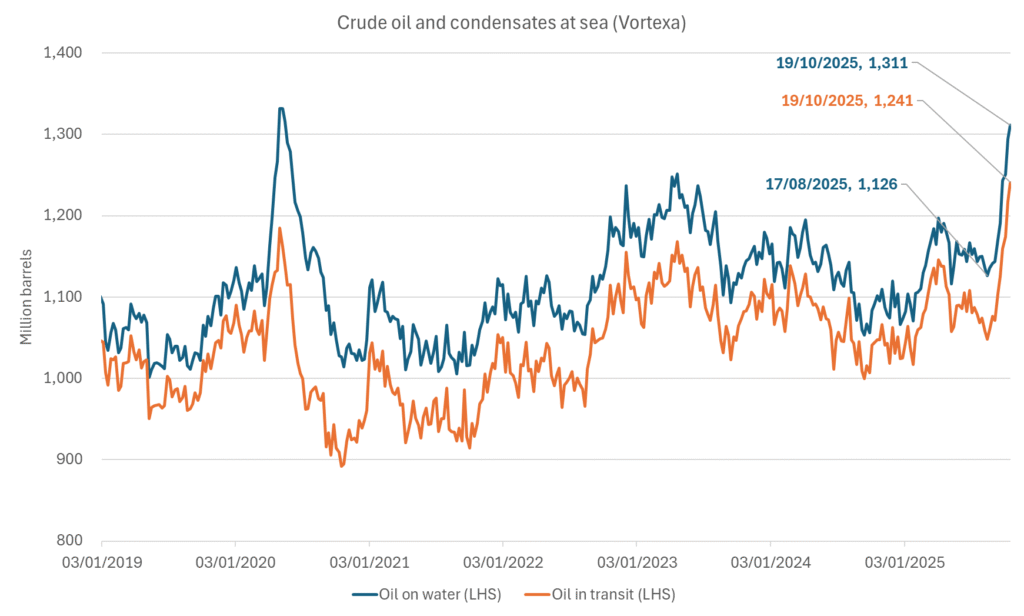
Crude oil floating storage (stationary more than 7 days). Down 11 mb over week to Sunday
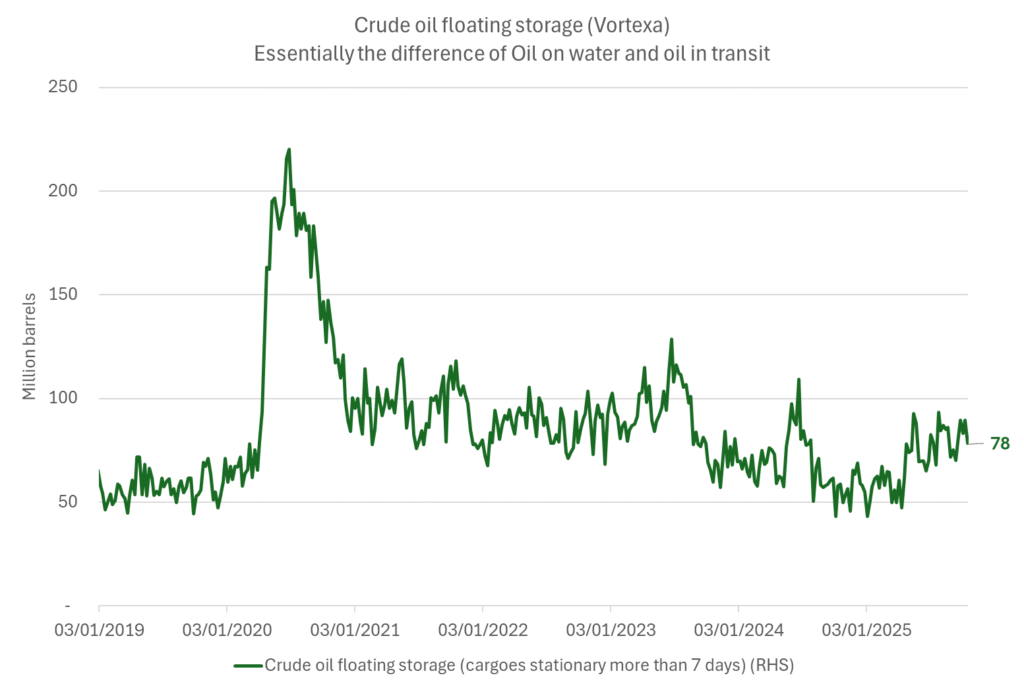
The lowest point of the Brent crude oil curve versus the 5yr contract. Weakest so far this year.
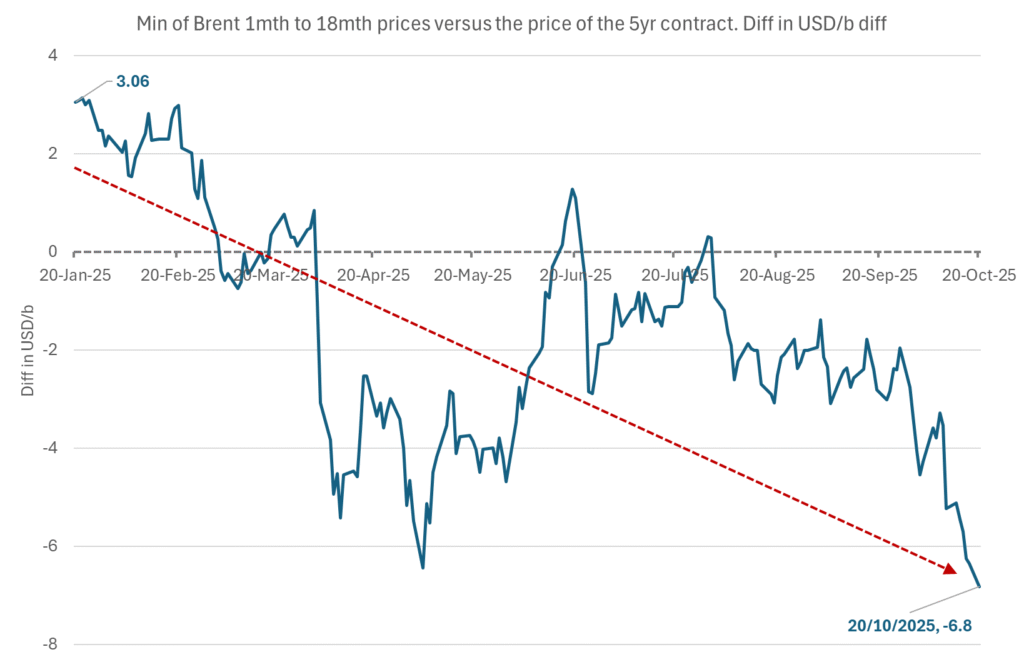
Crude oil 1mth to 3mth time-spreads. Dubai held out strongly through summer, but then that center of strength fell apart in late September and has been leading weakness in crude curves lower since then.
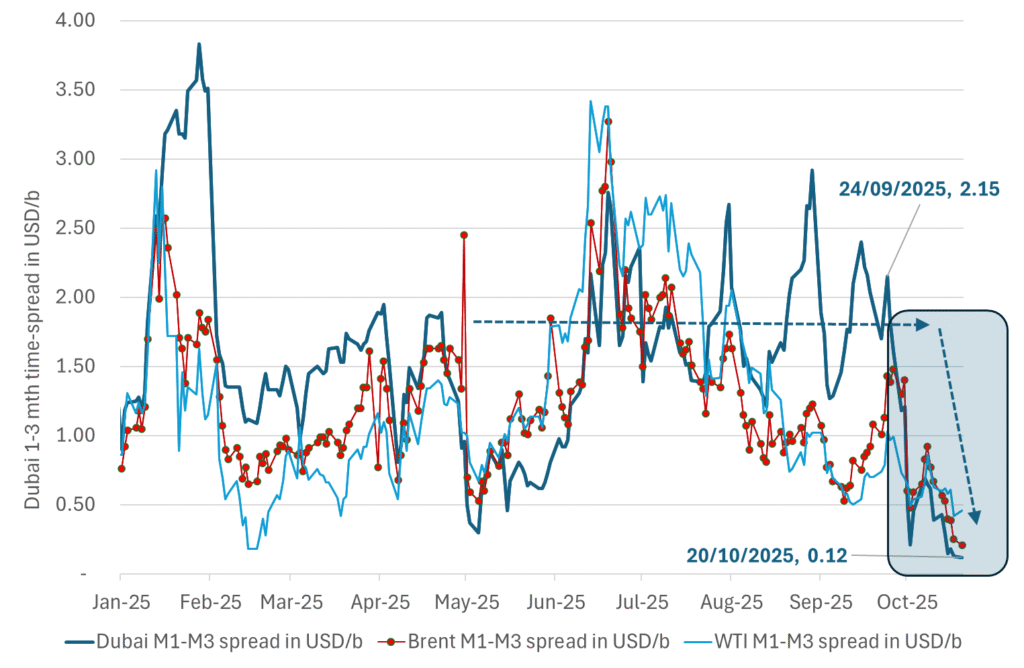
Analys
Crude oil soon coming to a port near you

Rebounding along with most markets. But concerns over solidity of Gaza peace may also contribute. Brent crude fell 0.8% yesterday to $61.91/b and its lowest close since May this year. This morning it is bouncing up 0.9% to $62.5/b along with a softer USD amid positive sentiment with both equities and industrial metals moving higher. Concerns that the peace in Gaza may be less solid than what one might hope for also yields some support to Brent. Bets on tech stocks are rebounding, defying fears of trade war. Money moving back into markets. Gold continues upwards its strong trend and a softer dollar helps it higher today as well.

US crude & products probably rose 5.6 mb last week (API) versus a normal seasonal decline of 2.4 mb. The US API last night partial and thus indicative data for US oil inventories. Their data indicates that US crude stocks rose 7.4 mb last week, gasoline stocks rose 3.0 mb while Distillate stocks fell 4.8 mb. Altogether an increase in commercial crude and product stocks of 5.6 mb. Commercial US crude and product stocks normally decline by 2.4 mb this time of year. So seasonally adjusted the US inventories rose 8 mb last week according to the indicative numbers by the API. That is a lot. Also, the counter seasonal trend of rising stocks versus normally declining stocks this time of year looks on a solid pace of continuation. If the API is correct then total US crude and product stocks would stand 41 mb higher than one year ago and 6 mb higher than the 2015-19 average. And if we combine this with our knowledge of a sharp increase in production and exports by OPEC(+) and a large increase in oil at sea, then the current trend in US oil inventories looks set to continue. So higher stocks and lower crude oil prices until OPEC(+) switch to cuts. Actual US oil inventory data today at 18:00 CET.
US commercial crude and product stocks rising to 1293 mb in week 41 if last nights indicative numbers from API are correct.
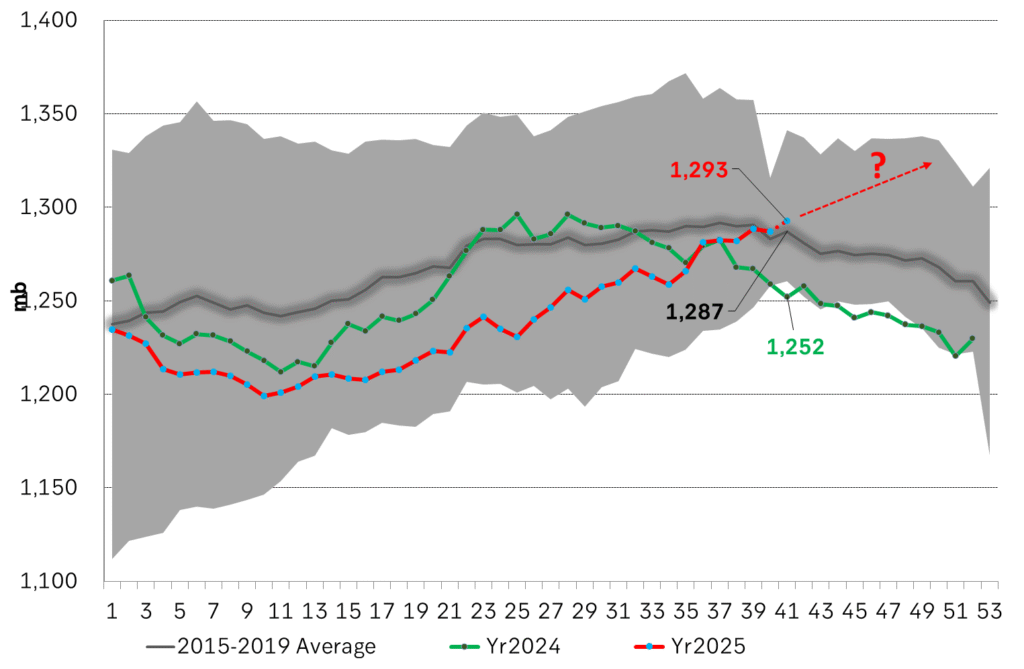
Crude oil soon coming to a port near you. OPEC has lifted production sharply higher this autumn. At the same time demand for oil in the Middle-East has fallen as we have moved out of summer heat and crude oil burn for power for air-conditioning. The Middle-East oil producers have thus been able to lift exports higher on both accounts. Crude oil and condensates on water has shot up by 177 mb since mid-August. This oil is now on its way to ports around the world. And when they arrive, it will likely help to lift stocks onshore higher. That is probably when we will lose the last bit of front-end backwardation the the crude oil curves. That will help to drive the front-month Brent crude oil price down to the $60/b line and revisit the high $50ies/b. Then the eyes will be all back on OPEC+ when they meet in early November and then again in early December.
Crude oil and condensates at sea have moved straight up by 177 mb since mid-August as OPEC(+) has produced more, consumed less and exported more.
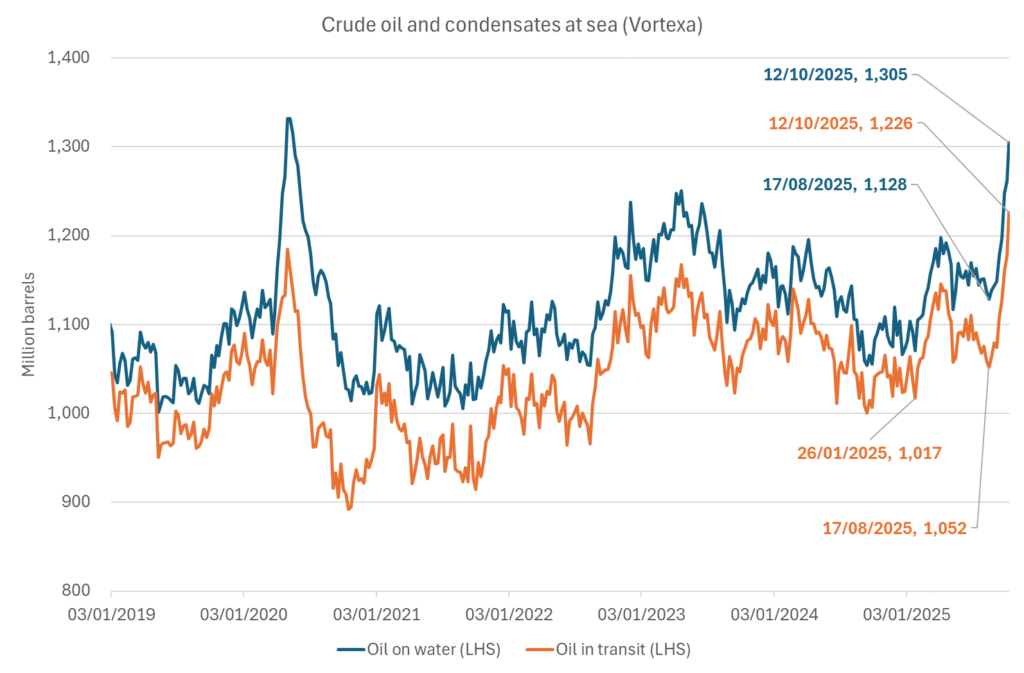
-

 Nyheter3 veckor sedan
Nyheter3 veckor sedanGoldman Sachs höjer prognosen för guld, tror priset når 4900 USD
-

 Nyheter4 veckor sedan
Nyheter4 veckor sedanBlykalla och amerikanska Oklo inleder ett samarbete
-

 Nyheter3 veckor sedan
Nyheter3 veckor sedanGuld nära 4000 USD och silver 50 USD, därför kan de fortsätta stiga
-
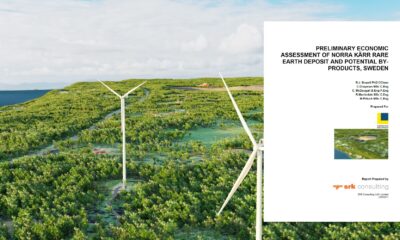
 Nyheter2 veckor sedan
Nyheter2 veckor sedanLeading Edge Materials är på rätt plats i rätt tid
-

 Nyheter3 veckor sedan
Nyheter3 veckor sedanNytt prisrekord, guld stiger över 4000 USD
-

 Nyheter4 veckor sedan
Nyheter4 veckor sedanEtt samtal om guld, olja, koppar och stål
-

 Analys4 veckor sedan
Analys4 veckor sedanOPEC+ will likely unwind 500 kb/d of voluntary quotas in October. But a full unwind of 1.5 mb/d in one go could be in the cards
-

 Nyheter4 veckor sedan
Nyheter4 veckor sedanNeptune Energy bekräftar enorma litiumfyndigheter i Tyskland








